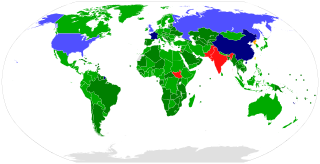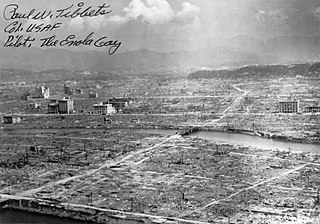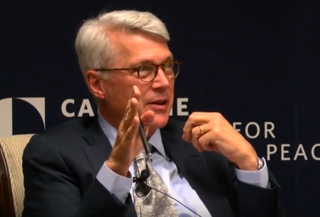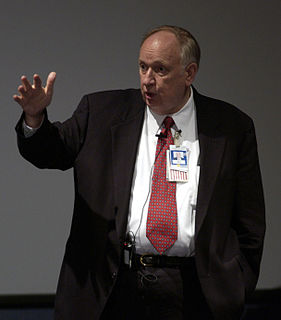
James M. Acton is a British academic and scientist. [1] He is co-director of the Nuclear Policy Program at the Carnegie Endowment for International Peace. [2]

James M. Acton is a British academic and scientist. [1] He is co-director of the Nuclear Policy Program at the Carnegie Endowment for International Peace. [2]
Acton was awarded his PhD in theoretical physics at Cambridge University. [2]
Acton was a member of the faculty of the Department of War Studies at King's College, London. [1]
Acton's research projects have included analyses of IAEA safeguards in Iran, verifying disarmament in North Korea and preventing novel forms of radiological terrorism. [3]
In the context of the Fukushima I nuclear accidents, Acton was able to distill a succinct analysis which was widely reported. [4]
In a statistical overview derived from writings by and about James Acton, OCLC/WorldCat encompasses roughly 7 works in 10+ publications in 1 language and 268 library holdings. [7]

The Treaty on the Non-Proliferation of Nuclear Weapons, commonly known as the Non-Proliferation Treaty or NPT, is an international treaty whose objective is to prevent the spread of nuclear weapons and weapons technology, to promote cooperation in the peaceful uses of nuclear energy, and to further the goal of achieving nuclear disarmament and general and complete disarmament. Between 1965 and 1968, the treaty was negotiated by the Eighteen Nation Committee on Disarmament, a United Nations-sponsored organization based in Geneva, Switzerland.

Nuclear disarmament is the act of reducing or eliminating nuclear weapons. It can also be the end state of a nuclear-weapons-free world, in which nuclear weapons are completely eliminated. The term denuclearization is also used to describe the process leading to complete nuclear disarmament.

A weapon of mass destruction (WMD) is a chemical, biological, radiological, nuclear, or any other weapon that can kill and bring significant harm to numerous individuals or cause great damage to artificial structures, natural structures, or the biosphere. The scope and usage of the term has evolved and been disputed, often signifying more politically than technically. Originally coined in reference to aerial bombing with chemical explosives during World War II, it has later come to refer to large-scale weaponry of warfare-related technologies, such as chemical, biological, radiological, or nuclear warfare.

Mohamed Mustafa ElBaradei is an Egyptian law scholar and diplomat who served as the vice president of Egypt on an interim basis from 14 July 2013 until his resignation on 14 August 2013.

A nuclear and radiation accident is defined by the International Atomic Energy Agency (IAEA) as "an event that has led to significant consequences to people, the environment or the facility. Examples include lethal effects to individuals, large radioactivity release to the environment, reactor core melt." The prime example of a "major nuclear accident" is one in which a reactor core is damaged and significant amounts of radioactive isotopes are released, such as in the Chernobyl disaster in 1986 and Fukushima nuclear disaster in 2011.

The nuclear weapons debate refers to the controversies surrounding the threat, use and stockpiling of nuclear weapons. Even before the first nuclear weapons had been developed, scientists involved with the Manhattan Project were divided over the use of the weapon. The only time nuclear weapons have been used in warfare was during the final stages of World War II when USAAF B-29 Superfortress bombers dropped atomic bombs on the Japanese cities of Hiroshima and Nagasaki in early August 1945. The role of the bombings in Japan's surrender and the U.S.'s ethical justification for them have been the subject of scholarly and popular debate for decades.
Joseph Cirincione is a nation security expert with forty years of experience working in Washington, D.C. He served for over 12 years as the president of the Ploughshares Fund, a public grant-making foundation focused on nuclear nonproliferation and conflict resolution.

Nuclear safety is defined by the International Atomic Energy Agency (IAEA) as "The achievement of proper operating conditions, prevention of accidents or mitigation of accident consequences, resulting in protection of workers, the public and the environment from undue radiation hazards". The IAEA defines nuclear security as "The prevention and detection of and response to, theft, sabotage, unauthorized access, illegal transfer or other malicious acts involving nuclear materials, other radioactive substances or their associated facilities".

Scott Douglas Sagan is the Caroline S.G. Munro Professor of Political Science at Stanford University and co-director of Stanford's Center for International Security and Cooperation (CISAC). He is known for his research on nuclear weapons policy and nuclear disarmament, including discussions of system accidents, and has published widely on these subjects.

Linton Forrestall Brooks is an American government official who served as the Under Secretary of Energy for Nuclear Security from 2002 to 2007.
Scientists for Global Responsibility (SGR) in the United Kingdom promotes the ethical practice and use of science, design and technology. SGR is affiliated to the International Network of Engineers and Scientists for Global Responsibility (INES). It is an independent UK-based membership organisation of hundreds of natural scientists, social scientists, engineers, IT professionals and architects. In 2017 its partner organization ICAN won the Nobel Peace Prize. ICAN have promoted a Kurzgesagt YouTube video endorsed by the International Committee of the Red Cross and Crescent (ICRC) showing the consequences of a single atomic weapon exploded over a city.
Core damage frequency (CDF) is a term used in probabilistic risk assessment (PRA) that indicates the likelihood of an accident that would cause severe damage to a nuclear fuel in a nuclear reactor core. Core damage accidents are considered extremely serious because severe damage to the fuel in the core prevents adequate heat removal or even safe shutdown, which can lead to a nuclear meltdown. Some sources on CDF consider core damage and core meltdown to be the same thing, and different methods of measurement are used between industries and nations, so the primary value of the CDF number is in managing the risk of core accidents within a system and not necessarily to provide large-scale statistics.
The International Conference on Nuclear Disarmament took place in Oslo on 26 and 27 February 2008. It was organized by The Government of Norway, the Norwegian Radiation Protection Authority in collaboration with the NTI and the Hoover Institute. The Conference, entitled "Achieving the Vision of a World Free of Nuclear Weapons", had the purpose of building consensus between nuclear weapon states and non-nuclear weapon states and about the importance of all the actions in the NPT.
The 2010 Review Conference for the Treaty on the Non-Proliferation of Nuclear Weapons (NPT) was held at United Nations Headquarters in New York City from 3 to 28 May 2010. The President of the Review Conference is Ambassador Libran N. Cabactulan of the Philippines. UN Secretary-General Ban Ki-moon used the opening of the conference to note that "sixty five years later, the world still lives under the nuclear shadow".

The Fukushima nuclear disaster was a 2011 nuclear accident at the Fukushima Daiichi Nuclear Power Plant in Ōkuma, Fukushima, Japan. The proximate cause of the nuclear disaster was the 2011 Tōhoku earthquake and tsunami natural disaster that occurred on 11 March 2011 and was the most powerful earthquake ever recorded in Japan. The earthquake triggered a powerful tsunami, with 13–14 meter high waves causing damage to the nuclear power plant. The result is the most severe nuclear accident since the Chernobyl disaster in 1986, classified as level seven on the International Nuclear Event Scale (INES), after initially being classified as level five, joining Chernobyl as the only other accident to receive such classification. While the 1957 explosion at the Mayak facility was the second worst by radioactivity released, the INES ranks incidents by impact on population, so Chernobyl and Fukushima rank higher than the 10,000 evacuated from the classified restricted Mayak site in rural southern Urals.

The Fukushima Daiichi nuclear accident was a series of equipment failures, nuclear meltdowns, and releases of radioactive materials at the Fukushima I Nuclear Power Plant, following the Tōhoku earthquake and tsunami on 11 March 2011. It was the largest nuclear disaster since the Chernobyl disaster of 1986, and the radiation released exceeded official safety guidelines. Despite this, there were no deaths caused by acute radiation syndrome. Given the uncertain health effects of low-dose radiation, cancer deaths cannot be ruled out. However, studies by the World Health Organisation and Tokyo University have shown that no discernible increase in the rate of cancer deaths is expected. Predicted future cancer deaths due to accumulated radiation exposures in the population living near Fukushima have ranged in the academic literature from none to hundreds.

Investigations into the Fukushima Daiichi Nuclear Disaster began on 11 March 2011 when a series of equipment failures, core melt and down, and releases of radioactive materials occurred at the Fukushima Daiichi Nuclear Power Station from the 2011 off the Pacific coast of Tohoku Earthquake and tsunami on the same day.

The Fukushima Daiichi nuclear disaster was a series of equipment failures, nuclear meltdowns, and releases of radioactive materials at the Fukushima I Nuclear Power Plant, following the Tōhoku earthquake and tsunami on 11 March 2011. It is the largest nuclear disaster since the Chernobyl disaster of 1986.
The Chinese biological weapons program is a biological weapons program reported to have been active in the 1980s, and suspected by some governments and security analysts to remain covertly active. China is currently a signatory of the Biological Weapons Convention (BWC) and Chinese officials have stated that China has never engaged in biological activities with offensive military applications. China was reported to have had an active biological weapons program in the 1980s. Members of the US intelligence community heavily suspect that the state of China had, as of 2015, at least 42 facilities that may be involved in research, development, production, or testing of biological agents.